
Global warming and the vows to mitigate the use of fuels around the world have escalated, leading to a market of clean energy sources. In this scenario, green hydrogen could help decarbonize the planet quicker, on the way to a sustainable energy future.
Green hydrogen results from the electric power generated by renewable energy sources through a process called “water electrolysis,” that is, separation of oxygen and hydrogen.
The most recent half-year report of the World Bank claims that the production and export of green hydrogen could spur the Latin American and Caribbean economy.
The good prospects of green hydrogen in Latin America and the Caribbean are due to their vast renewable energy sources.
The World Bank surmises that should the region succeed in leading the production of green hydrogen, it could manage its own energy transition and supply the European and Asian markets. As a matter of fact, the export of the clean fuel from Latin America is a clue to inclusive, resilient and green economic recovery.
According to the World Bank, Chile has taken the lead in the implementation of renewable energy sources, averaging 20% of total production. In addition, the country is regarded as one of the meccas of solar energy and it was a pioneer in the region when launching its “green hydrogen domestic strategy,” in November 2020.
Chile is the only country in Latin America with two development projects. The first one, HyEx, in Antofagasta, will use solar energy to power electrolisers of 1.6 GW. The second one involves Enaex (the Chilean company of mining services and Highly Innovative Fuels (HIF). This is the second largest project of its kind in Latin America, implying an investment of US$ 51 million and the use of renewable energy sources and carbon dioxide from the atmosphere to produce 350 tons of methanol and 130,000 liters of fuel annually, at the end of 2022.
“We are happy to start today a project that could shift current energy sources for transportation, providing clean fuels for vehicles and helping decarbonize the planet,” said César Norton, the CEO of HIF.
Chile is expected to be at the forefront of the world production of green hydrogen in a question of three decades. By 2030, the Santiago airport will be the first one in Latin America operating with green hydrogen and its byproducts.
